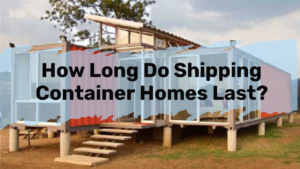When we think of a container home, a big metal box is what may first come to mind. Something that’s durable, and deals with shipping freight and other things that comes over seas.
The last thing to think is that it’s unsafe. But like everything, no matter how safe we think something might be, safety precautions should always be considered.
Strengths
A shipping container is very sturdy. It’s made of thick metal to prevent any kind of puncture or damage to freight coming over seas.
This also includes the strength to handle natural disasters such as earthquakes, hurricanes, tornadoes, typhoons, snow you name it.
This doesn’t mean that the container won’t be tossed around back and forth, but it means that the container is more likely to handle these conditions rather than a regular conventional home.
A shipping container weighs roughly 24 thousand to a little over 67 thousand pounds. That’s a lot of weight to be moved. Just think of what that means if used for a home.
Old, Used Containers
The good thing about buying a used container is it’s cheaper than a new one. Although cheaper, used containers may require some maintenance because it is probably not considered to be livable in its current condition. So, if you purchase a used shipping container with the idea or turning it into a home, remember that used container will need a make over.
A few issues with a used container, could be the presence of rust, rust holes, chemical residue from spills, punctures from forklifts and/or other heavy industrial machinery, and even mold. These issues will not meet many building codes and regulations, making the containers uninhabitable.
Anyone interested in purchasing a used container will want to have rust holes or punctures patched by a good wielder. Another thing to consider is to have the company clean or abrasive blast the container before it is purchased by the new owner.
This procedure consists of sanding the paint off the container and having it repainted with a non-toxic protective paint. On top of this, it can be requested to have the old flooring removed and cleaned of any previous chemical spillage.
Heat
A container home is made of metal and metal is a good conduit of heat. This means that the container can become quite hot in extreme heat conditions.
Since a container can do that, having it properly insulated can help to reduce the heat. There are a variety of methods and materials that can be used to achieve this.
For instance, a cheap eco friendly method is using some recycled material such as denim, cork, recycled newspaper, wool, straw, or cotton.
These are just a few of the alternative materials that can be used to help reduce heat for a container.
There are more costly methods and materials such as using fiberglass, polystyrene, rock wool, closed and open spray foam.
These will help insulate better than the eco friendly material and last longer but many of these options are more hazardous to the ozone and your health.
Is a Container Home Less Likely to Get Broken Into?
A large container is hard to break into. It has only one entrance, through the front double, sometimes-triple locked entrance. It’s meant to be airtight but, once you’ve converted a container home into a home, it may consist of windows, a front door, and back door. These are all break in entry points for a thief.
Now, if you’d like to retain the same protection as an unmodified container, than yes it would be very hard to break into. But as it’s modified to be a home, it would be just as likely get broken into as a conventional home. So, making sure you have your home locked down properly will lessen your chances of getting broken into.
Some of those entry points are:
*Front door
*First-floor window
*Back door
*Garage
*Unlocked entrance
*Second floor
Tips to Help Prevent Break-ins
Some tips to help prevent a break-in is when you’re not home, shut the windows and blinds. Don’t make it easier for an intruder to see into your home.
If they see something they want, they’ll try to find a way in. Keep your investments blind from wandering eyes.
Another tip is to simply lock your doors that lead to the outside. Lock them when you’re at home and when you leave.
The list provided even shows that it’s possible for a break-in through the second floor, so keep those blinds closed, windows and doors locked.
Another tip to help prevent or lessen the chance of a break-ins, is to own a dog or have an alarm system. Burglars are less likely to try and break in.
Making Your Container Home Safe
Turning a shipping container into a home requires some modifications, especially if it is an old or used container. As stated before, making it safe may require regulating heat by insulation; repairing rusts by abrasive blasting old paint, patching holes by wielding, and cleaning any residue caused by spillages.
If you’re lucky to get a new container, it may not have to be cleaned like an old or used one, but it would still require to be modified with heat insulation, windows, regular and/or glass sliding doors.
When thinking about safety, the same rules apply whether you live in a conventional or a container home. Remember to lock your windows and doors, shut your blinds or close your curtains. Having a dog and an alarm system are good options that will let you know when someone’s around.
Take all the precautions necessary to make your container home safe.


